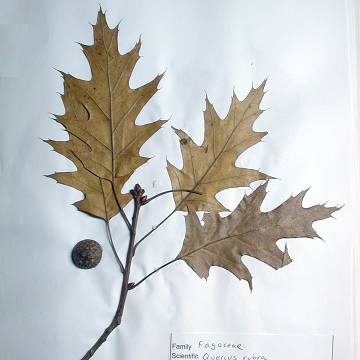

Quercus rubra - (image 1 of 5)
Taxonomy
Family: Fagaceae
Synonymous with Q. borealis.
Habitat
Rich, mesic woods. Old dune slopes. River banks and well-drained slopes
Associates
Distribution
Nova Scotia and Prince Edward Island south to GA, west to MN and OK.
Morphology
Deciduous tree to 80' high. Terminal buds ovoid, 3-7 mm, with glabrous or ciliate scales. Leaves simple, alternate, with 7-11 bristle-tipped lobes; the lobes usually cut less than halfway to the midrib. Acorn cups broad and shallow, mostly more than 1.8 cm wide, with tightly appressed scales, the nut more than 2 cm long.
Notes
Flowers mid to late May
Wetland indicator: Facultative Upland
Black Oak (Q. velutina Lam.) has similar leaves and can be distinguished by the 4-angled terminal buds that are densely hairy. In addition the acorn-cup is turbinate and covers about half the nut, with the inner scales of the cup loose and forming a fringe. Black Oak occurs in dry upland soils and dunes from southern ME to MI and southeast MN, south to FL and TX.
References
Gleason, Henry A. and A. Cronquist. 1991. Manual of Vascular Plants of Northeastern United States and Adjacent Canada. Second Ed.
The New York Botanical Garden. Bronx, NY
Illinois Department Natural Resources. December 1995. Common Illinois Trees
IDNR Educational Services: Project Learning Tree.
Swink, F. and G. Wilhelm. 1994. Plants of the Chicago Region.
Indiana Academy of Science. The Morton Arboretum. Lisle, Illinois.
|
Michael Hough © 2005 |